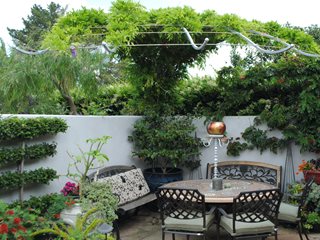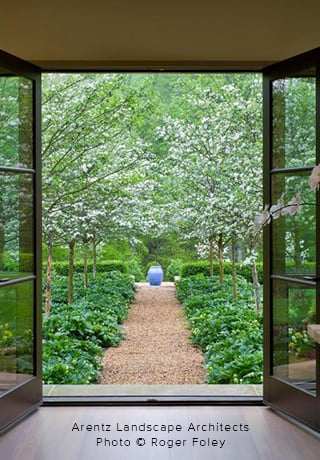Creating a Sense of Enclosure

Resembling a giant wave, this creative arbor is covered with blooming wisteria and creates the perfect enclosure for the dining area in this front garden. The Costarakis Garden. Photo by: Rebecca Sweet.
Creating a sense of enclosure in the garden is an easy way to transform it from a simple outdoor space into a cozy, personal retreat. Enclosures provide a peaceful sanctuary to unwind, read a book, or enjoy a cup of tea, creating a sense of privacy, security, and comfort. Through the clever use of everyday elements to create these cozy areas, they add depth and structure to the garden and transform it into a multi-dimensional space.
But, just as important, creating a sense of enclosure also adds a sense of mystery and discovery to the garden, with new sights and experiences around every corner. Whether using a permanent built-in structure, upcycled everyday items, or a clever use of plants, the sky’s the limit when creating your unique private hideaway.
CREATING A SENSE OF ENCLOSURE WITH STRUCTURES
Permanent structures, such as arbors, pergolas, freestanding trellises, or stand-alone follies, are excellent options for creating a year-round sense of enclosure in your garden. In larger gardens, arbors and pergolas are ideal ways to carve intimate spaces out of an expansive area. This will not only make your garden more inviting but can also become a charming vignette that can serve as a focal point.

Elaborate structures aren’t the only solution for creating a sense of enclosure. Sometimes, the simple outline of an overhead pergola is enough to suggest a sense of enclosure, effectively acting as the ceiling of your outdoor room. The Mathews Garden, designed by Land Morphology. Photo by: Rebecca Sweet.
Arbors
Although the terms "arbor" and "pergola" are often used interchangeably, they are distinctly different structures. An arbor frequently incorporates a trellis into its design, typically along its sides, as decoration and support for climbing plants. Often, an arbor has an arched shape and can be used within the garden or at the beginning (or end) of a pathway, serving as a charming entryway or focal point. Additionally, arbors are usually smaller in scale than pergolas, making them perfect for creating cozy spots in the garden.

Covered with scented climbing roses, this arbor creates a cozy, intimate atmosphere for this hidden garden nook. The Tanner Garden. Photo by: Rebecca Sweet.
Pergolas
Like arbors, pergolas can also support climbing plants, but they are typically larger in scale. Pergolas have four vertical posts supporting an open roof-like structure of crossbeams and open lattice, providing partial shade and a sense of openness while defining an outdoor space. This design creates a spacious and airy environment, perfect for creating an outdoor room. At the same time, the framework is ideal for supporting larger climbing vines, such as wisteria, grapevines, clematis, or climbing roses.

This long, narrow pergola adds a sense of privacy while obscuring the neighboring roofline and creating a cozy setting near the family pool. Photo by: Rebecca Sweet.
Garden Nooks
A garden nook is typically a small, cozy corner or alcove within the garden designed to offer a peaceful retreat from the rest of the outdoor space. It’s often strategically placed for privacy and seclusion, featuring comfortable seating, such as a bench or a set of chairs. To help enhance the sense of intimacy, surround this space with lush greenery, favorite flowers (scented is a bonus!), or tall and weeping plants. The goal is to create a charming, secluded spot to relax, read, or enjoy the garden's serenity.
When artfully created with personality and detailed design elements, garden nooks serve a functional purpose and become stunning focal points, adding charm and character to your garden.

This artfully designed garden nook adds charm and character to the garden, but thanks to the comfortable seating and overhead roof, it’s usable throughout the year. The Tanner Garden. Photo by: Rebecca Sweet.
GARDEN ROOMS
Creating garden rooms is a fantastic way to add a sense of enclosure and exploration to your outdoor space. Similar to the rooms in a house, outdoor rooms also need walls and ceilings (or at least the illusion of them) to create a sense of intimacy and to define the space. Using elements such as trellises, pergolas, and strategically placed plants, you can craft both the “ceiling” and “walls” of a garden room, enhancing privacy while defining distinct areas.
It may seem counterintuitive to those with small gardens, but adding a garden room or two makes small spaces feel more expansive. A common pitfall of small gardens is viewing the entire garden with one glance (often resulting in an overcrowded and cramped feeling.) However, adding a garden room or nook creates the illusion of a larger, more expansive space when encouraged to walk through the garden to discover all it has to offer.

Let your creativity flow! Intimate garden rooms were created within this large space with the clever use of upcycled antique doors and windows. As the 'walls' of this garden rooms illustrate, sometimes just the illusion of screening is all that is needed to create a private atmosphere. Photo by: Rebecca Sweet.
CREATING A SENSE OF ENCLOSURE WITH PLANTS
While non-living, permanent structures are great for creating a sense of enclosure, remember the power of plants! Using towering perennials, hedges (both low and tall), or even groupings of containers, a sense of intimacy is created while also adding color, texture, and scent. When strategically using plants this way, they create dynamic, ever-changing enclosures that grow and evolve with the seasons. They can soften the lines of hardscaping, attract wildlife, and enhance the overall sensory experience of your garden, resulting in an immersive and delightful retreat.

The clipped hedge (Pittosporum tenuifoium ‘Marjorie Channon’) creates an evergreen ‘wall’ for this front-yard courtyard, keeping the space private and intimate, yet low enough to remain friendly to passersby in the neighborhood. The Montegue Garden. Photo by: Rebecca Sweet.
Weeping Plants
Weeping and draping plants are an excellent way to create a sense of enclosure in your garden. Taller plants with gracefully cascading branches and leaves add a soft, natural curtain that enhances privacy and defines spaces without solid barriers.
The flowing forms of plants, such as weeping willows, Grevillea ‘Long John’, or Ceanothus ‘Ray Hartman,’ add a touch of elegance and movement, creating a dynamic and romantic atmosphere. By strategically planting these draping beauties, you not only help to create secluded nooks and cozy corners but, depending on the plant itself, create a stunning focal point.

The giant fronds of the false hemp (Datisca cannabina) are allowed to gracefully drape over the pathway, forming a curtain and inviting curious visitors to pass through to the next garden room. The Bellevue Botanical Garden. Photo by: Rebecca Sweet.
Tree Canopy
More extensive gardens can sometimes feel uninviting when surrounded by expansive spaces, definitely not conducive to intimate gatherings. However, one strategy to tame a large garden is to bring down its scale through the use of taller plants and trees. A tree canopy can act as the ‘ceiling’, the first step in creating a sense of enclosure. To continue creating a cozy space, place comfortable seating under the canopy and perhaps a few mid-sized perennials or a container overflowing with colorful annuals.

The canopy of a singular tree helps break up this expansive garden and creates an ideal shady spot secluded from the rest of the garden. Wave Hill Garden. Photo by: Rebecca Sweet.
Hedges
Hedges, whether low, medium, or tall, are excellent for creating a sense of enclosure within a garden space. Low hedges can define the borders of a cozy nook while maintaining an open feel. Medium-height hedges offer a balance of privacy and openness, making them ideal for separating different sections of the garden. Tall hedges, on the other hand, provide substantial privacy and can serve as natural walls, completely shielding certain areas from view. A bonus is the dense foliage of many hedges, which can serve as a habitat for wildlife and add another dynamic layer to your garden.

The low boxwood hedge surrounding this secluded seating area has just enough height to act as the ‘walls’ of this nook, creating a private space yet remaining open and non-obtrusive to view the rest of the garden. The Tanner Garden. Photo by: Rebecca Sweet.
Berms
Creating berms in the garden is a favorite strategy for enhancing privacy with plants. A berm provides an additional "lift," adding height and privacy where needed while remaining open and welcoming. Even if the berm is no more than 14 inches at its highest point, once planted, it creates a natural barrier that can blend seamlessly with the rest of the garden. Moreover, the elevation changes introduced by berms can help drainage and prevent soil erosion, offering practical benefits and aesthetic improvements. This method allows you to craft a more dynamic and private garden environment without the need for fences or walls, maintaining your garden's natural and open feel.

Though only 16 inches in height, the densely planted berm provides the perfect amount of privacy (and noise reduction) from the busy street. Photo by: Rebecca Sweet.

BOOK REBECCA AS YOUR NEXT GARDEN SPEAKER!
Fun, passionate, and knowledgeable, three words that describe Rebecca Sweet! See what discussion topics are available and watch a short video as Rebecca explains how her talks will inspire, entertain, and educate gardeners at all skill levels.
RELATED:
More from Rebecca Sweet
Designing With Foliage Over Flowers
10 Essential Elements & Principles of Garden Design
